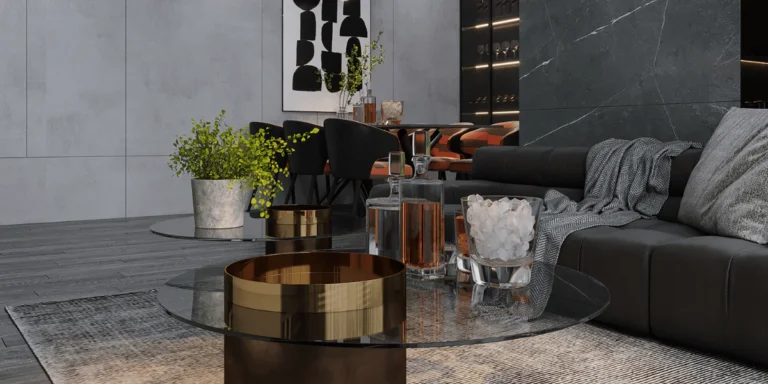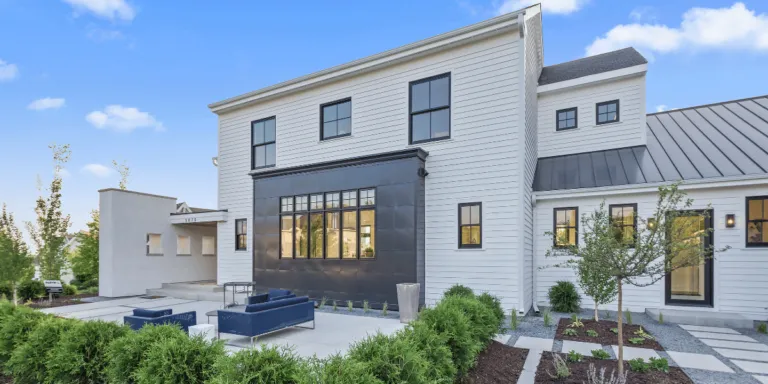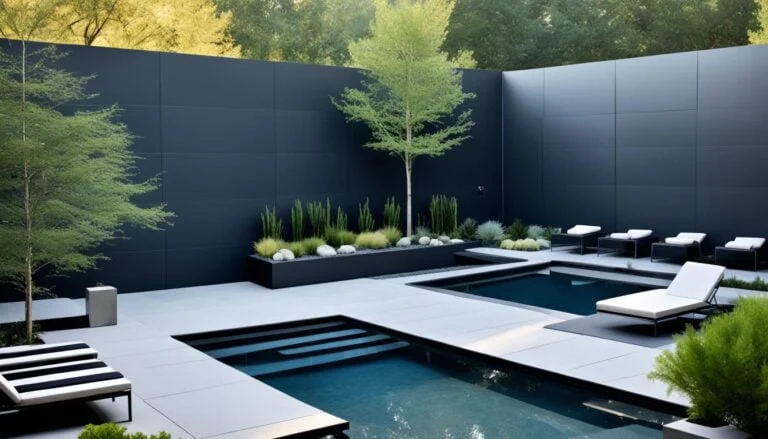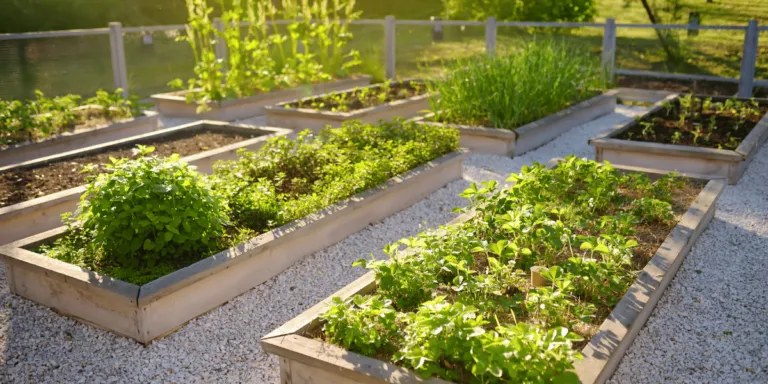Welcome to our article on therapeutic garden design, where we explore the incredible healing power of nature and how it can positively impact our well-being. Therapeutic gardens design, also known as healing gardens or mindfulness gardens, provide a peaceful outdoor sanctuary for individuals seeking solace and tranquility.
These specially designed spaces offer a unique opportunity for individuals to connect with nature, promoting both mental and physical healing. Whether found in healthcare facilities, rehabilitation centers, or community spaces, therapeutic gardens have become a valuable asset in supporting individuals in their journey towards wellness.
In this article, we will delve into the different types of therapeutic gardens, the key elements that make them effective, and how you can create your own healing space. Join us as we explore the remarkable benefits of therapeutic garden design and its capacity to enhance our overall well-being.
Key Takeaways:
- Therapeutic gardens design, also known as healing gardens or mindfulness gardens, are outdoor spaces specifically designed to improve mental and physical well-being.
- These gardens provide a calming interaction with nature, benefiting both patients and their loved ones.
- Therapeutic gardens design can be categorized into different types, such as healing gardens, enabling gardens, meditative gardens, rehabilitative gardens, and restorative gardens.
- All therapeutic gardens design share common design elements, including well-defined perimeters, sensory stimulating plant selections, and accessibility features.
- Establishing specific goals for your therapeutic garden and prioritizing design features based on those goals is essential for creating a meaningful and effective space.
The Five Types of Therapeutic Gardens Design
Therapeutic gardens can be classified into five different types: healing gardens, enabling gardens, meditative gardens, rehabilitative gardens, and restorative gardens. Each type serves a specific purpose in promoting healing, well-being, and mindfulness.
1. Healing Gardens
Healing gardens utilize the principles of horticultural therapy to aid in physical, mental, and emotional healing. These gardens are carefully designed to create a serene and calming environment, promoting relaxation and stress reduction. They provide a space for individuals to reconnect with nature and find solace in its beauty and tranquility.
2. Enabling Gardens
Enabling gardens focus on physical recovery and rehabilitation. These gardens often integrate vocational training programs in horticulture to empower individuals and enhance their skills for future employment in the field. Enabling gardens provide opportunities for active gardening and physical therapy, fostering a sense of purpose and accomplishment.
3. Meditative Gardens
Meditative gardens are designed to create peaceful environments for quiet reflection and stress reduction. These gardens feature elements such as Zen gardens, labyrinth paths, and soothing water features. Meditative gardens encourage mindfulness practices, offering a space for individuals to engage in meditation, yoga, or simply find inner peace.
4. Rehabilitative Gardens
Rehabilitative gardens serve not only the healing of the gardeners but also the environment. These gardens focus on environmental restoration, conservation, and sustainable practices. They allow individuals recovering from physical or mental challenges to actively participate in regenerating the natural world, fostering a sense of environmental stewardship and connection.
5. Restorative Gardens
Restorative gardens provide sanctuaries for individuals to find calm and relieve stress after traumatic events. These gardens offer a safe and supportive environment for emotional healing and recovery. Restorative gardens may incorporate features such as healing circles, memorial spaces, and therapeutic artwork, serving as havens of solace and renewal.
| Type of Therapeutic Garden | Main Purpose |
|---|---|
| Healing Garden | Aid in physical, mental, and emotional healing through horticultural therapy. |
| Enabling Garden | Focus on physical recovery and vocational training in horticulture. |
| Meditative Garden | Create peaceful environments for quiet reflection and stress reduction. |
| Rehabilitative Garden | Serve both the healing of gardeners and environmental restoration. |
| Restorative Garden | Provide sanctuary for individuals to find calm and relieve stress after traumatic events. |
As each type of therapeutic garden offers unique benefits, individuals and organizations can choose the one that aligns with their specific goals and needs. The design and features incorporated into each garden type contribute to its overall therapeutic effect, creating spaces that promote healing, empowerment, and a deep connection with nature.
Common Elements of Design in Therapeutic Gardens
All therapeutic gardens share some common elements in their design. These features are carefully incorporated to create a serene and healing environment that promotes well-being and mindfulness. Whether in a healthcare facility or a community space, therapeutic gardens are designed to offer a sense of tranquility and sensory stimulation. Let’s explore the essential design features that make therapeutic gardens effective spaces for healing and relaxation.
1. Calming Elements
Therapeutic gardens aim to create a peaceful atmosphere that promotes relaxation. Incorporating calming elements such as soft colors, gentle water features, and soothing sounds can help individuals find inner peace and reduce stress. The use of natural materials, like bamboo or timber, can enhance the overall tranquility of the space.
2. Sensory Stimulation
Engaging the senses is a crucial aspect of therapeutic garden design. Selecting a variety of plants that evoke different textures, scents, and colors can provide sensory stimulation and increase overall well-being. Fragrant flowers, rustling leaves, and vibrant blooms contribute to a multisensory experience that promotes mindfulness and connection with nature.
3. Accessibility
Creating a space that is accessible to everyone is essential in therapeutic garden design. Accessible pathways, ramps, and handrails ensure that individuals with physical limitations can easily navigate and enjoy the garden. Providing seating options at various heights and incorporating raised planting beds allow individuals of all abilities to participate in gardening activities.
4. Scheduled Activities
Some therapeutic gardens offer scheduled activities led by professional therapists. These activities can include garden therapy sessions, guided meditation, or horticultural workshops. Scheduled activities provide structured engagement and support the therapeutic goals of the garden. However, not all therapeutic gardens have scheduled activities, and their presence depends on the specific needs and objectives of the space.
Incorporating these design features into a therapeutic garden helps create a harmonious and healing environment that nurtures the mind, body, and soul. When designing a therapeutic garden, it is crucial to consider the goals of the space and the needs of the individuals who will be using it.
A Short History of Therapeutic Gardens Design

Therapeutic gardening has a long historical background, with roots dating back to ancient times. The practice of ancient horticulture therapy involved using gardens and plants for their calming effect on the senses, promoting physical and emotional well-being. This ancient wisdom recognized the healing power of nature, and it laid the foundation for the modern therapeutic garden.
In more recent history, a notable figure in the development of therapeutic gardens was Dr. Benjamin Rush. A prominent physician in the late 18th century, Dr. Rush recognized the positive effects of working in the garden for individuals with mental disabilities. He realized that gardening could provide a therapeutic outlet, offering solace and aiding in their recovery.
However, it was after World War 2 that therapeutic gardens gained widespread popularity. With a large number of veterans returning from the war, many of whom were experiencing physical and psychological traumas, horticulture therapy became a key component of their rehabilitation. Gardening provided a healing and meaningful activity, allowing veterans to connect with nature, find solace, and regain a sense of purpose.
Since then, horticultural therapy has continued to evolve and is now widely accepted as a practice for physical and psychological healing. It is utilized in various settings, including healthcare facilities, rehabilitation centers, and community gardens. Therapeutic gardens have become spaces of refuge, promoting well-being, and improving the quality of life for individuals of all ages and abilities.
Through the centuries, the understanding and appreciation of therapeutic gardens have grown, and they continue to provide immense benefits to countless individuals today. Whether it is the ancient horticulture therapy, the pioneering work of Benjamin Rush, or the post-World War 2 popularity, the historical background of therapeutic gardens serves as a testament to the enduring power of nature in promoting physical, mental, and emotional well-being.
Establishing Goals for Your Therapeutic Garden Design

When creating a therapeutic garden, it is important to establish specific goals based on individual or community needs. By understanding the desired outcomes, you can design a garden that is tailored to meet the personalized healing needs of its users. Let’s explore two key goal-oriented approaches for therapeutic gardens: restorative gardens and enabling gardens.
Restorative Garden Goals
Restorative gardens focus on enhancing quality of life and promoting restoration of physical, mental, and emotional well-being. These gardens provide a soothing environment for relaxation, stress reduction, and inner peace. The goal is to create a space that rejuvenates and brings harmony to individuals who are experiencing physical or emotional challenges.
To prioritize design features for a restorative garden, consider incorporating elements that promote tranquility and relaxation. This may include:
- Comfortable seating areas for contemplation and meditation
- Soothing water features, such as fountains or flowing streams
- Nurturing plant selections with soft colors and fragrances
- Amply shaded areas to provide relief from harsh sunlight
- Accessible pathways to accommodate individuals with mobility limitations
By prioritizing these specific design features, restorative gardens can provide a peaceful sanctuary for reflection and healing.
Enabling Garden Goals
Enabling gardens are designed with the primary goal of providing opportunities for active gardening and physical recovery. These gardens aim to empower individuals to engage in horticultural activities that promote physical rehabilitation, skill development, and vocational training.
To prioritize design features for an enabling garden, consider incorporating elements that support active participation and accessibility. This may include:
- Raised beds or vertical gardening structures to accommodate individuals with limited mobility
- Workstations and tools designed for ease of use and ergonomic comfort
- Vocational training areas to promote skill building and potential career opportunities
- Adaptive gardening tools for individuals with physical limitations
- Clear pathways and ample space for wheelchair maneuverability
By prioritizing these specific design features, enabling gardens can provide a nurturing environment that supports physical recovery and personal growth through gardening activities.
When establishing goals for your therapeutic garden, it’s crucial to consider the specific needs and preferences of the individuals or community you are designing for. By prioritizing the right design features based on these goals, you can create a personalized healing space that promotes well-being and engages users in meaningful ways.
Designing the Elements of Your Therapeutic Garden
In order to create a truly therapeutic garden space, it is important to carefully consider the elements that will contribute to the overall experience. From hardscaping to seating options, each element plays a crucial role in fostering a healing environment. Let’s explore the key design elements that can make your therapeutic garden a haven of tranquility and restoration.
Hardscaping
Hardscaping refers to the non-living elements of your garden, such as paths, patios, and walls. These features not only serve a functional purpose but also help define the space and create a sense of unity. By strategically incorporating hardscaping into your garden design, you can create a harmonious balance between nature and man-made structures, enhancing the overall aesthetic appeal.
Water Features
Water has long been associated with relaxation and serenity. Including water features, such as fountains, ponds, or waterfalls, in your therapeutic garden can provide a sense of tranquility and help create a soothing atmosphere. The gentle sound of flowing water can contribute to the meditative experience, promoting a sense of peace and calm.
Sound and Lighting
Sound and lighting elements can greatly enhance the therapeutic experience in your garden. Consider incorporating windchimes or gentle music to create a serene ambience, providing auditory stimulation and promoting mindfulness. Additionally, carefully planned lighting can highlight the natural beauty of your plants, creating a warm and inviting atmosphere even after the sun sets.
Wildlife Attraction
Bringing nature to your therapeutic garden not only includes plants but also creating habitat for wildlife. By selecting native plants and providing resources such as bird feeders, birdhouses, or butterfly gardens, you can attract a variety of wildlife to your garden. The presence of birds, butterflies, and other creatures adds to the healing energy and fosters a deeper connection with nature.
Seating Options
Comfortable seating is an essential element of any therapeutic garden. Whether it’s a bench tucked away in a quiet corner or a cozy chair by a water feature, providing ample seating options allows visitors to sit and immerse themselves in the tranquil surroundings. The seating should be inviting and comfortable, encouraging relaxation and contemplation.
Focal Points
Creating focal points within your therapeutic garden can help guide attention and serve as points of meditation and reflection. This could be a beautifully sculpted statue, an eye-catching plant, or a uniquely designed structure. Focal points draw the eye and provide a focal center for individuals to connect with and find solace amidst the beauty of the garden.
By carefully designing and incorporating these elements into your therapeutic garden, you can create a space that nurtures healing, mindfulness, and well-being. Let the elements of hardscaping, water features, sound and lighting, wildlife attraction, seating options, and focal points come together to establish an environment that promotes restoration and rejuvenation.
Choosing and Growing Plants for Your Therapeutic Garden
When it comes to creating a therapeutic garden, the selection of plants plays a crucial role in promoting a healing and sensory experience. Consider the following factors when choosing and growing plants for your therapeutic garden:
Plant Selection
Start by selecting plant varieties that are well-suited for the climate in your region. Research local native plants or consult with a local garden center to ensure your choices will thrive and require minimal maintenance. By choosing plants that are adapted to the local environment, you can reduce the need for excessive watering, fertilizers, and pesticides, making your garden eco-friendly and sustainable.
Reducing Maintenance
Incorporating low-maintenance plants can significantly reduce the time and effort required to upkeep your therapeutic garden. Group plants with similar care needs together, creating zones that facilitate efficient watering and maintenance. This approach not only simplifies your gardening tasks but also allows you to focus on enjoying and benefiting from the therapeutic aspects of your garden.
Personal Preferences and Evoking Memories
Your personal preferences should play a role in the plant selection process. Consider choosing plants that evoke positive memories, such as flowers or herbs from your childhood or those that have a particular scent associated with positive emotions. These personal touches can enhance the emotional and sensory experience of your therapeutic garden, making it a truly personal and healing space.
In addition to personal preferences, select plants that provide a variety of sensory experiences. Include plants with soft textures, vibrant colors, and aromatic scents to stimulate different senses and create a multisensory therapeutic environment.
Growing Your Own Tea
Another unique aspect to consider is growing your own tea plants. Incorporating herbs such as chamomile, lavender, or mint can provide opportunities for relaxation and self-care. Harvesting and preparing your own homegrown herbal teas can add a sense of satisfaction and accomplishment to your therapeutic garden journey, as well as a deeper connection to the healing power of nature.
Remember, as you choose and grow plants for your therapeutic garden, always prioritize climate suitability, reducing maintenance, personal preferences, evoking memories, and the potential to grow your own tea. By carefully selecting and cultivating plants, you can create a vibrant and nurturing outdoor space that promotes healing and well-being.
Conclusion
Therapeutic gardens design offer a multitude of benefits for individuals seeking stress reduction, physical and mental healing, and overall well-being. By creating a healing space in your own home or community, you can provide yourself with a sanctuary for relaxation and reflection.
However, designing a therapeutic garden that meets your specific goals and needs can be a complex task. That’s where professionals, such as landscape architects, come in. Working with these experts can help ensure that your therapeutic garden design is tailored to meet your unique requirements.
Remember, therapeutic gardening is a journey that requires time and effort, but the rewards are immeasurable. So start creating your own healing space today, and let the power of nature transform your well-being.
FAQ
What are therapeutic gardens design?
Therapeutic gardens design, also known as healing gardens, are outdoor spaces specifically designed to improve mental and physical well-being.
Where can therapeutic gardens design be found?
Therapeutic gardens design can be found in healthcare facilities, rehabilitation centers, and even in community spaces.
What are the different types of therapeutic gardens?
The different types of therapeutic gardens are healing gardens, enabling gardens, meditative gardens, rehabilitative gardens, and restorative gardens.
What elements do therapeutic gardens have in common?
Common elements in therapeutic gardens include a well-defined perimeter, a variety of interactive possibilities, intentional plant placement, sensory stimulating plant selections, and accessibility features for individuals with physical limitations.
What is the history of therapeutic gardens?
Therapeutic gardening has a long history, dating back to ancient times. In more recent history, horticulture therapy gained popularity among recovering veterans after World War 2.
How should I establish goals for my therapeutic garden?
It is important to establish specific goals based on individual or community needs. Restorative gardens focus on quality of life and restoration, while enabling gardens aim to provide opportunities for active gardening and physical recovery.
What elements should I consider when designing my therapeutic garden?
The elements to consider when designing a therapeutic garden include hardscaping, water features, sound and lighting, wildlife attraction, seating options, and focal points.
How do I choose and grow plants for my therapeutic garden?
When selecting plants for a therapeutic garden, it is important to choose varieties suitable for the climate and reduce maintenance by grouping together plants with similar needs. Personal preferences and the desired emotional and sensory impact should also be taken into consideration.
What are the benefits of therapeutic gardens?
Therapeutic gardens offer a range of benefits, including stress reduction, physical and mental healing, and overall well-being.










